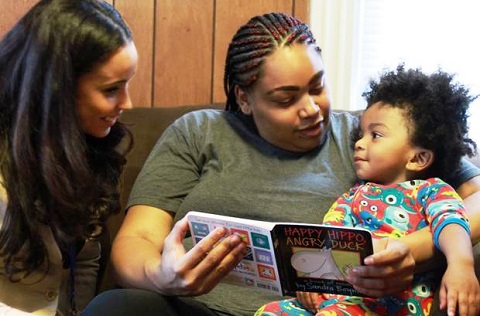
In the United States, children in lower income homes are exposed to 30 million fewer words than their wealthier peers by the time they are 3 years . This means that by the time they enter kindergarten, they are behind in literacy and vocabulary.
In Latin America and the Caribbean we have been trying to address the socioeconomic gradients that influence vocabulary problems for a while, so I was really interested in an article in The New Yorker from early this year. The article mentioned a program in Providence, Rhode Island, that innovates in the use of technology to promote language development in young children. Could a program like this be rolled out sustainably in our countries? In an effort to learn more about this experience, I had the privilege of interviewing Caitlin Molina, Program Manager of Providence Talks. Here is what I learned.
Can you tell me a little bit about the history of Providence Talks?
Providence Talks was created as a Bloomberg initiative. We won the Bloomberg Philanthropies’ 2012-2013 Mayors Challenge and received a 5 million dollar grant with the idea to target children birth to three who may be exposed to less language within the home than their higher income peers.
What does the Providence Talks intervention promotes?
We wanted to create a program that would track the language that exists within a home and also model it with a home visiting curriculum: pair the technology and the home visiting curriculum to give parents strategies and tools to overcome this obstacle and make sure that children are ready and prepared for Kindergarten and are able to have the best opportunities possible for them. Right now in Providence, two thirds of our children entering Kindergarten are already behind in literacy benchmarks.
How do you use technology in your program?
We use technology developed by the Lena research foundation. It is a digital language processor, a word pedometer. It doesn’t actually record what is being said, it counts the number of words and conversational interactions within the home. We are able to filter out any media noise such as television and radio and count the number of words the child uses, the number of words the adult uses and then the conversational turns which is an interaction.
Looking at that and knowing that children ideally should be exposed to 21 thousand words in a day, we use this technology to count the number of words and to really understand both the quality and the quantity of language that exists within the home. This is paired with the home visitor and our curriculum, which is available on our website. We want to give families a lot of opportunities to incorporate language expansion strategies within their already existing daily routines. So we are not asking families to change their day or to change their routine, we are simply adding ideas, benefits and strategies that they can incorporate into this daily routine to really better enhance the language exposure.
How old are the children you serve?
We enroll children from 2 months to 30 months of age; however, we will follow that child beyond their third birthday for the entire length of the program-1 year.
There is a scheduled recording every two weeks for the first five months of the program and then we check it at months 6, 9 and 12. We have the family do a recording 10-16 hours long. After the home visitors pick up the devices and upload the recordings, they print out a recording report that they share with the family at the next home visit. They go over what the results of the recording were and model the activities and strategies to help further enhance language.
What is the profile of your program’s home visitors and how does the program trains and mentors them?
All of our home visitors have a bachelor’s degree.
Prior to them going into the home, we train on the technology, the philosophy, the theory behind the device, as well as on the curriculum. And then we constantly do refresher trainings. I, as a program manager, schedule a shadow home visit with the home visitors so that I can offer feedback to them based on first-hand experience.
How large is the Program? What are your plans to scale up?
We have 15 home visitors. We are reaching 62 actively participating families and there are others that have already graduated from the program.
We are evaluating the pilot program that was the first year of the grant. Now we are planning a full roll out for this spring and that is 1500-2500 new children over a 3 year grant period.
How do you monitor program quality?
We have monthly supervisor meetings with the home visitors. We also do home visitor focus groups and family focus groups. They are able to offer a lot of great feedback that we can use.
Tell us about the evaluation of the pilot program
The evaluation results are not public. We partnered with Brown University and they’ve done an independent evaluation of the pilot program using a random control trial. As of January 30th, preliminary data from our pilot families show that families that started with low word counts have shown an increase of 50% in their word count and 30% in their conversational turn count, or the verbal exchanges between the child wearing the device and their caregiver.
What do you think your community could learn from this experience? Let us know in the comments section below or in Twitter.
Para leer esto post en español, haz click aquí.

Leave a Reply